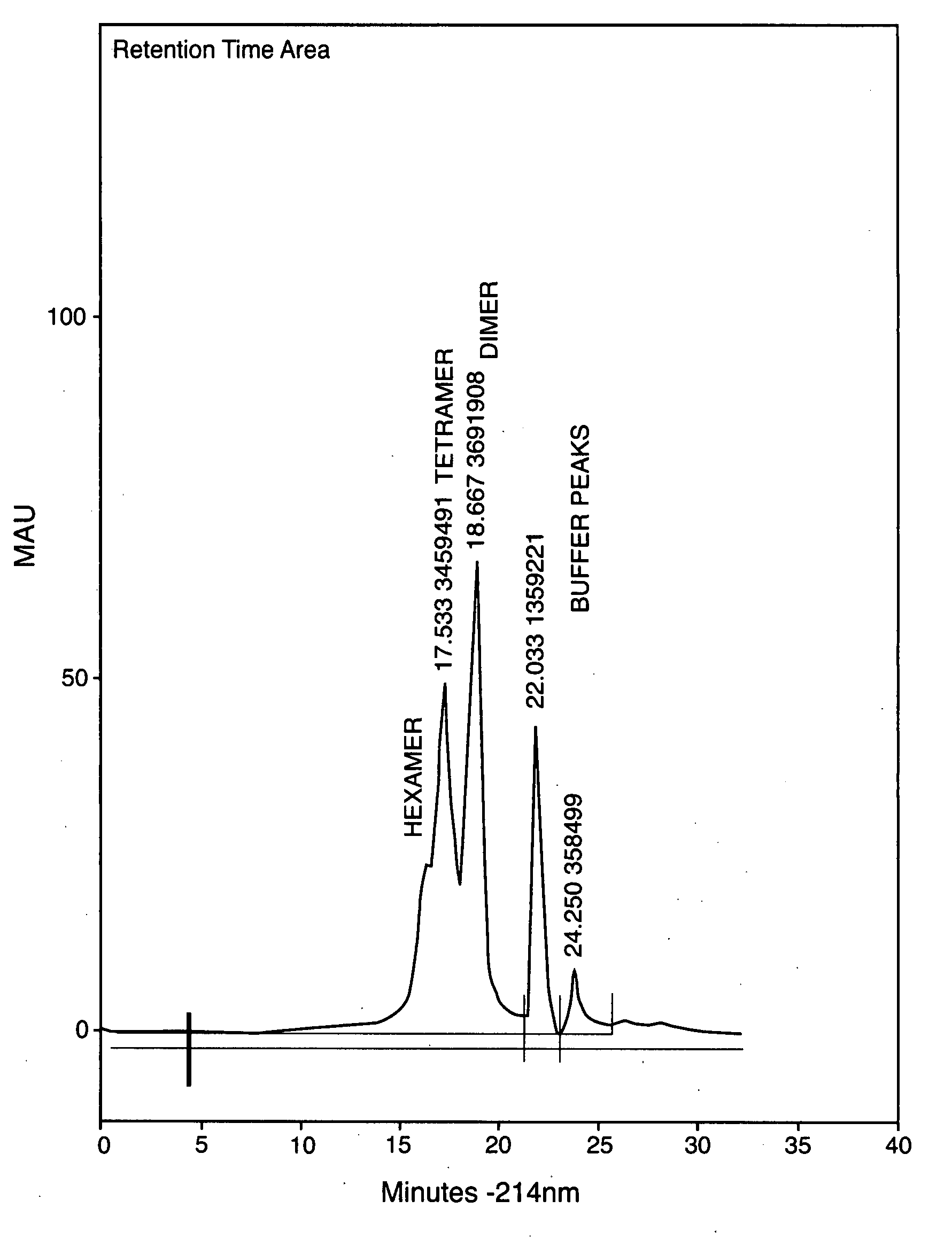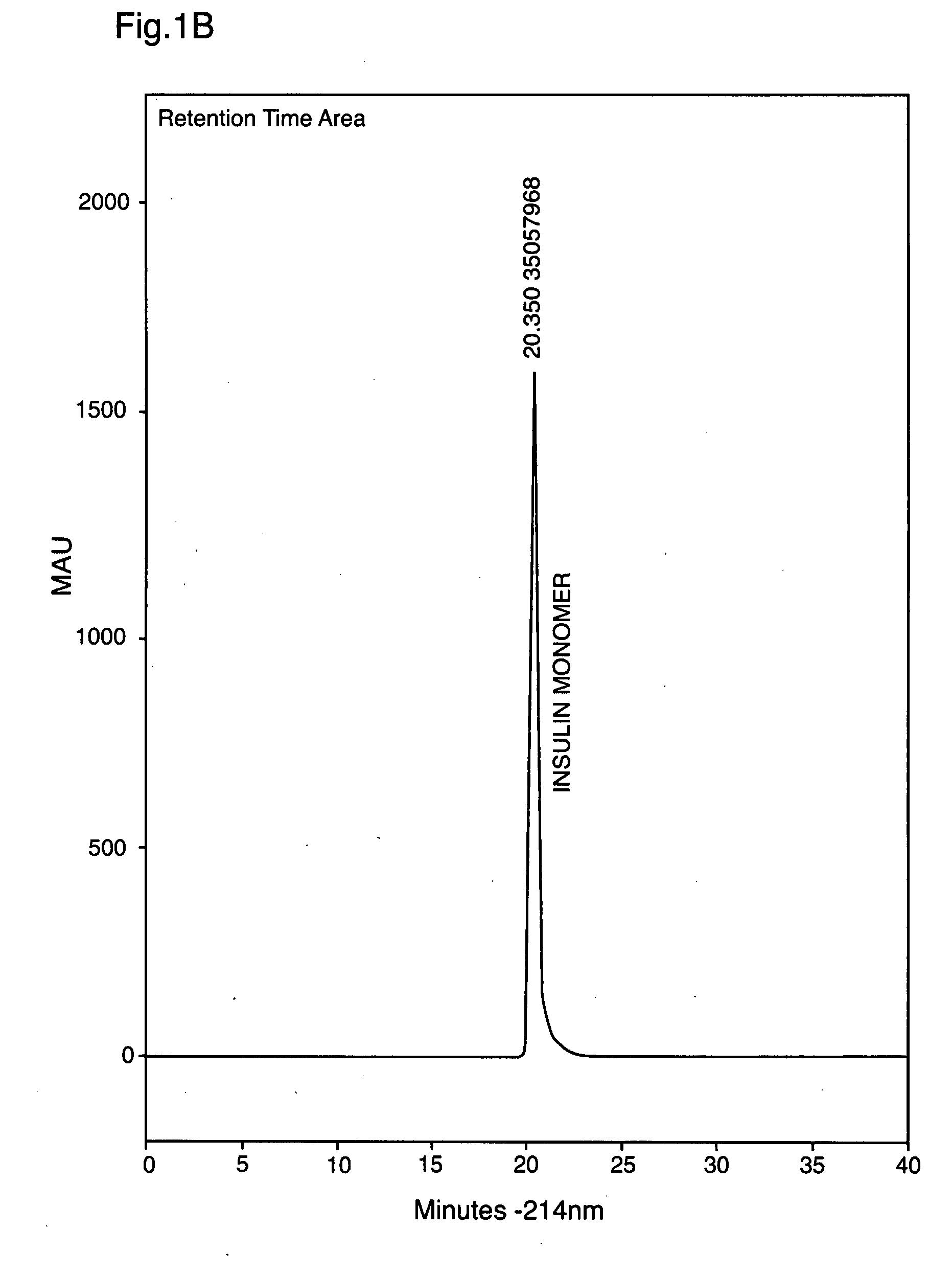Derivatized insulin oligomers
a technology of insulin oligomers and oligomers, applied in the field of medicine, can solve the problems of affecting the normal functioning of the body, so as to reduce the hypoglycaemic effect and prolong the action for glucose control, and achieve the effect of reducing the hypoglycaemic effect and reducing the risk of micro-vascular and macrovascular sequela
- Summary
- Abstract
- Description
- Claims
- Application Information
AI Technical Summary
Benefits of technology
Problems solved by technology
Method used
Image
Examples
example 1
[0076]Insulin prepared by the methods described in (Markussen, et al, U.S. Pat. No. 4,916,212 filed May 29, 1985; issued Apr. 10, 1990) was dialyzed to remove all zinc, so as to optimise the post-reaction formation of appropriate monomeric precursors for P-insulin oligomers. Phosphorylation at −2 to +2° C. using a minimum starting concentration of 50 mM potassium phosphate, and excess POCl3 (360 μL) for 60 minutes caused phosphate concentrations to reach solubility limits. This produced high yields of oligomeric phosphorylated insulin. Oligomers were separated by size exclusion chromatography on Zorbax 250 column, or similar columns using Q Sepharose, employing 50 mM ammonium phosphate buffer (pH 9.0) with 1% (v / v) acetonitrile. Dimers, trimers, tetramers and hexamers of phosphorylated insulin can be prepared in this manner as shown in FIGS. 1a, 2a. The retention times of the insulin monomer is shown in FIG. 1b for comparison. Samples were bracketed by HPLC analysis of appropriate m...
example 2
[0077]Human Pro-insulin was prepared as per U.S. Pat. Nos. 4,559,300, Kovacevic, S. et al. issued Dec. 17, 1985, Di Marchi R., filed Aug. 1, 1983; 4,616,078, Di Marchi R, filed Oct. 7, 1986 and converted into human insulin by the methods described in U.S. Pat. No. 4,639,333, Obermeier R. et al., filed Jan. 27, 1987. Phosphorylation at −2 to 0° C. used a minimum starting concentration of 50 mM sodium phosphate, and excess POCl3 (360 μL) for 60 minutes reaction. The reaction was quenched with 5-fold volume of de-ionized ice. High yields of oligomeric phosphorylated insulin were obtained. Oligomers were separated by size exclusion chromatography on a Zorbax 250 column, employing 50 mM ammonium phosphate buffer (pH 9.0) with 1% (v / v) acetonitrile. Dimers, trimers, tetramers and hexamers of phosphorylated insulin could be prepared in this manner
example 3
[0078]A formulation of P-insulin oligomers was prepared as follows. 40 mg of P-insulin tetramer separated as above by size-exclusion chromatography was added to 9 mL of 15 mmolar sodium phosphate, 50 mmol NaCl. Glycerol was added to make the solution isotonic at the final volume. The pH was adjusted to 7.4 with 1 N NaOH and / or 1N HCl. M-cresol / phenol were added at equimolar concentrations of 0.125% (based on 10 mL final volume). Volume was made to 10 mL and the formulation sterile filtered and stored at 4° C.
PUM
| Property | Measurement | Unit |
|---|---|---|
| Therapeutic | aaaaa | aaaaa |
| Effective dose | aaaaa | aaaaa |
Abstract
Description
Claims
Application Information
 Login to View More
Login to View More - R&D
- Intellectual Property
- Life Sciences
- Materials
- Tech Scout
- Unparalleled Data Quality
- Higher Quality Content
- 60% Fewer Hallucinations
Browse by: Latest US Patents, China's latest patents, Technical Efficacy Thesaurus, Application Domain, Technology Topic, Popular Technical Reports.
© 2025 PatSnap. All rights reserved.Legal|Privacy policy|Modern Slavery Act Transparency Statement|Sitemap|About US| Contact US: help@patsnap.com



